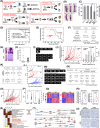Inhibition of mTOR attenuates the initiation and progression of BRCA1-associated mammary tumors
- PMID: 39826130
- PMCID: PMC11999881
- DOI: 10.1002/cac2.12663
Inhibition of mTOR attenuates the initiation and progression of BRCA1-associated mammary tumors
Conflict of interest statement
The authors declare no conflict of interest.
Figures

References
-
- Venkitaraman R. Triple‐negative/basal‐like breast cancer: clinical, pathologic and molecular features. Expert Rev Anticancer Ther. 2010;10(2):199–207. - PubMed
-
- Nanda R. “Targeting” triple‐negative breast cancer: the lessons learned from BRCA1‐associated breast cancers. Semin Oncol. 2011;38(2):254–262. - PubMed
Grants and funding
LinkOut - more resources
Full Text Sources
Miscellaneous

